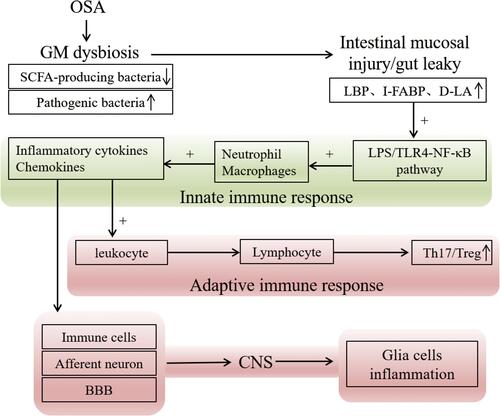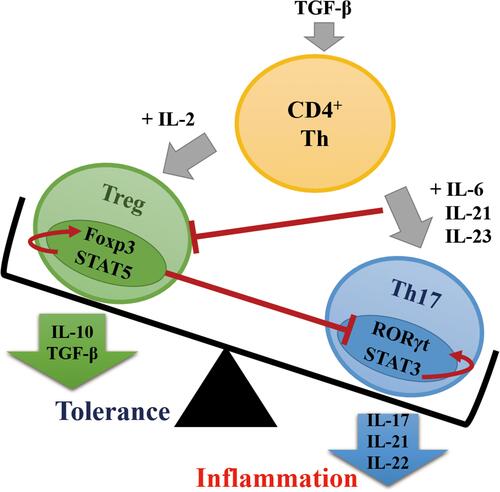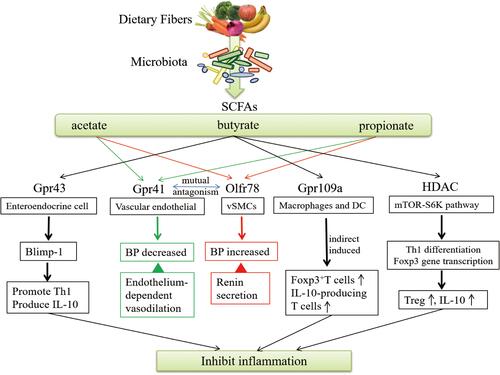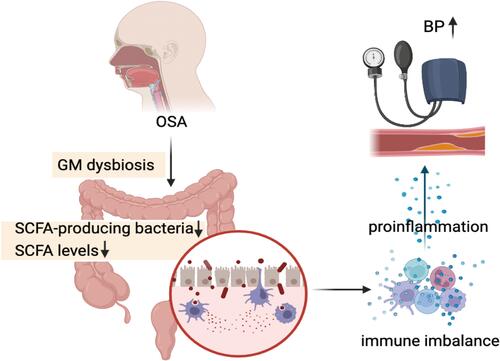Figures & data
Figure 1 OSA causes immune disorders. Dysbiosis of the intestinal flora, leads to a decrease in SCFA-producing flora, an increase in pathogenic bacteria in feces, and damage to the intestinal mucosa, which increases circulating LPS, which activates TLR4 receptors and activates NF-κB inflammatory channels triggering an inflammatory cascade of intestinal, circulatory, and neurological inflammatory response.

Figure 2 Differentiation of CD4+ T cells into Th17 or Treg cells under different cytokine environments. Foxp3 is highly expressed in the absence of proinflammatory factors and induced by high concentrations of TGF-β, promoting the differentiation of CD4+ T cells into Treg cells and CD4+ T cells into Th17 cells, when low concentrations of TGF-β are present together with the inflammatory cytokines IL-6, IL-21, and IL-23.

Figure 3 SCFA regulate blood pressure through receptor channels and the immune system. Acetate and propionate mediate renin secretion via Olfr78 receptors to increase blood pressure and endothelium-dependent vasodilation via Gpr41 to decrease blood pressure; butyrate acts on Gpr43, upregulates Blimp-1, induces IL-10 secretion from Th1 cells, and on Gpr109a, induces Tregs differentiation and IL-10 secretion; butyrate and propionate inhibit HDAC activity through the mTOR-S6k pathway, suppress Th1 and Th17 differentiation, and induce CD4+CD25+ Treg differentiation with IL-10 secretion. Black arrow ![]()
 represents blood pressure regulation.
represents blood pressure regulation. , elevated;
, elevated;  , reduced; Blimp-1, B lymphocyte-induced maturation protein 1; BP, blood pressure; Olfr78, Olfactory receptor 78; vSMCs, vascular smooth muscle cells; HDAC, histone deacetylase; GPR, G-protein-coupled receptors; Th, effector T cells; Treg, regulatory T cells; Foxp3, forkhead box P3; IL, interleukin.
, reduced; Blimp-1, B lymphocyte-induced maturation protein 1; BP, blood pressure; Olfr78, Olfactory receptor 78; vSMCs, vascular smooth muscle cells; HDAC, histone deacetylase; GPR, G-protein-coupled receptors; Th, effector T cells; Treg, regulatory T cells; Foxp3, forkhead box P3; IL, interleukin.
Figure 4 The postulated pathophysiology of OSA-associated hypertension mediating inflammation from gut microbiome dysbiosis crosstalk between with immune imbalance. In OSA patients, structural reorganization of the gut microbiota due to the altered intestinal lumen environment and the decrease of fecal SCFA lead to “leaky gut”, which triggers an intrinsic and adaptive immune response leading to a low-grade inflammatory state in the body that damages the vascular endothelium and causes vasodilatation disorders and atherosclerosis, ultimately leading to hypertension.

